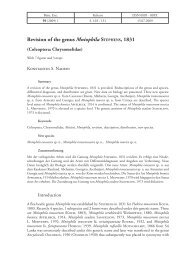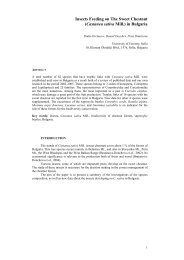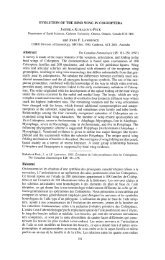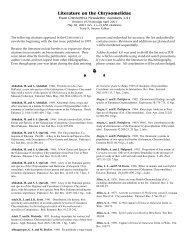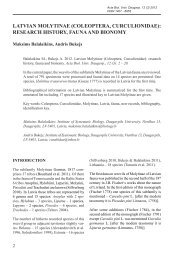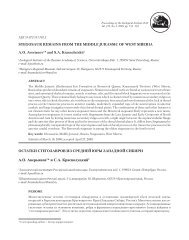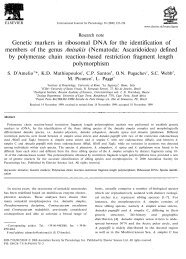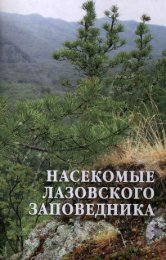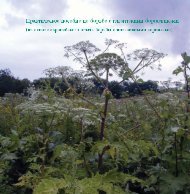Checklist of the Cerambycidae, or longhorned beetles (Coleoptera ...
Checklist of the Cerambycidae, or longhorned beetles (Coleoptera ...
Checklist of the Cerambycidae, or longhorned beetles (Coleoptera ...
Create successful ePaper yourself
Turn your PDF publications into a flip-book with our unique Google optimized e-Paper software.
2<br />
Larval <strong>Cerambycidae</strong> also display a variety <strong>of</strong> habits. Most species feed within dead,<br />
dying <strong>or</strong> even decaying wood, but some taxa are able to utilize living plant tissue. Girdlers<br />
(adults <strong>of</strong> <strong>the</strong> Onciderini, larvae <strong>of</strong> genera in <strong>the</strong> tribes Methiini, Hesperophanini and<br />
Elaphidiini) sever living branches <strong>or</strong> twigs, with <strong>the</strong> larvae developing within <strong>the</strong> nutrient-rich<br />
distal p<strong>or</strong>tion. The larvae <strong>of</strong> a few species move freely through <strong>the</strong> soil, feeding externally upon<br />
roots <strong>or</strong> tunneling up under <strong>the</strong> root crown. Digestion <strong>of</strong> cellulose appears to be aided primarily<br />
by <strong>the</strong> presence <strong>of</strong> enzymes ra<strong>the</strong>r than symbiotic micro<strong>or</strong>ganisms. In many cases,<br />
<strong>Cerambycidae</strong> are primary b<strong>or</strong>ers in woody plants, providing a vital "first step" in <strong>the</strong> biological<br />
recycling <strong>of</strong> <strong>the</strong>se materials. Larval feeding habits typically result in frass-filled galleries <strong>or</strong><br />
tunnels under <strong>the</strong> bark <strong>or</strong> within <strong>the</strong> sapwood <strong>of</strong> <strong>the</strong> host plant, terminating in a pupal chamber,<br />
wherein <strong>the</strong> metam<strong>or</strong>phosis from last-instar larva to pupa to adult takes place. The life spans <strong>of</strong><br />
most species in temperate regions typically range from one to three years, but many variations<br />
exist, and cycles <strong>of</strong> from two <strong>or</strong> three months to several decades have been documented.<br />
Tropical species may be less constrained seasonally, and some populations <strong>of</strong> smaller genera<br />
literally may breed continuously, with all stages being found on and in <strong>the</strong> same pieces <strong>of</strong> wood.<br />
Most <strong>of</strong> <strong>the</strong> overall lifetime is spent in <strong>the</strong> larval stage, with adult <strong>beetles</strong> usually emerging,<br />
dispersing, reproducing, and dying within a span <strong>of</strong> but a few days to a few months.<br />
Several species <strong>of</strong> cerambycid <strong>beetles</strong> are known to damage living trees, and may<br />
seriously affect <strong>or</strong>chards and <strong>or</strong>namental trees; o<strong>the</strong>rs may damage coniferous <strong>or</strong> hardwood<br />
lumber, and a few taxa can damage row crops. The maj<strong>or</strong>ity <strong>of</strong> species, however occur within<br />
uncultivated <strong>or</strong> f<strong>or</strong>ested habitats, and while <strong>the</strong>y are <strong>of</strong> great ecological imp<strong>or</strong>tance within <strong>the</strong>se<br />
natural ecosystems, <strong>the</strong>y are <strong>of</strong> little human economic significance. Because <strong>of</strong> <strong>the</strong>ir close<br />
evolutionary linkage to <strong>the</strong>ir host plants, cerambycid <strong>beetles</strong> may be valuable bio-indicat<strong>or</strong>s <strong>of</strong><br />
f<strong>or</strong>est health and diversity, with differing suites <strong>of</strong> species found within primary f<strong>or</strong>est habitats<br />
than those which occur within disturbed areas <strong>or</strong> secondary growth.<br />
<strong>Checklist</strong> <strong>or</strong>der<br />
Subfamilies are arranged in traditional checklist <strong>or</strong>der, although Napp (1994) has<br />
provided a phylogenetic analysis which suggests <strong>the</strong> following sequence: Anoplodermatinae,<br />
Parandrinae, Prioninae, Spondylidinae, Lepturinae, Aseminae, Cerambycinae, Lamiinae. Tribal<br />
classifications within <strong>the</strong> subfamilies have not been evaluated phylogenetically, so <strong>the</strong>ir <strong>or</strong>dering<br />
is alphabetical. It is acknowledged that this results in <strong>the</strong> artificial separation <strong>of</strong> similarappearing<br />
(and undoubtedly closely related) taxa (i.e., Anaglyptini – Clytini – Tillom<strong>or</strong>phini;<br />
Acanthocinini – Colobo<strong>the</strong>iini; Bothriospilini – T<strong>or</strong>neutini), and <strong>the</strong> breakup <strong>of</strong> <strong>the</strong> lamiine<br />
tribes with bifid tarsal claws. However, <strong>the</strong> functional value <strong>of</strong> a checklist is as an <strong>or</strong>ganizing<br />
reference tool, and f<strong>or</strong> that reason-- and until such time as a tribal phylogeny has been<br />
determined-- <strong>the</strong> <strong>or</strong>dering is arranged f<strong>or</strong> ease <strong>of</strong> use. Genera and species also are listed<br />
alphabetically. Citation <strong>of</strong> auth<strong>or</strong>, year and page number follows each taxon name, with<br />
synonymies cited in italics. Geographical distributions listed reflect <strong>the</strong> present knowledge <strong>of</strong> <strong>the</strong><br />
auth<strong>or</strong>s and previous published data, and are subject to expansion as new inf<strong>or</strong>mation is<br />
contributed. An eff<strong>or</strong>t has been made to verify all contributed rec<strong>or</strong>ds, but <strong>the</strong> possibility exists<br />
that some erroneous identifications have led to inc<strong>or</strong>rect distributional parameters f<strong>or</strong> some<br />
species. These are c<strong>or</strong>rected as we become aware <strong>of</strong> <strong>the</strong>m. State <strong>or</strong> o<strong>the</strong>r provincial citations<br />
have been used where known f<strong>or</strong> some larger countries to m<strong>or</strong>e accurately indicate known




